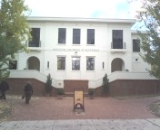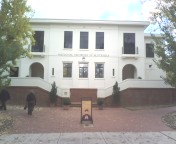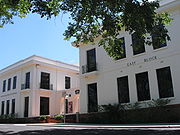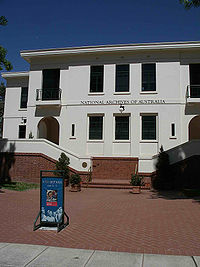
National Archives of Australia
Encyclopedia
The National Archives of Australia is a body established by the Government of Australia
for the purpose of preserving Commonwealth Government records. It is an Executive Agency of the Department of the Prime Minister and Cabinet
and reports to the Cabinet Secretary
, Senator Joe Ludwig
.
The national office is in Canberra
with offices in each state capital and Darwin
. As of June 2007, the National Archives had 437 staff, of which 246 (56.3%) were women. The Archives' budget for 2007-2008 was $
86.98 million, with $
66.8 million provided by the Commonwealth government. The chief executive officer is the Director-General. The agency is divided into five branches: National Coordination, Access and Communication, Archive Operations and Preservation, Government Information Management and Corporate, each headed by an Assistant Director-General.
In addition to caring for its collection, the National Archives develops and tour exhibitions, publishes books and guides to the collection and delivers educational programs. It also advises other government departments and agencies on records management
.
 The foundation stone for a National Archives was laid by Edward, Prince of Wales
The foundation stone for a National Archives was laid by Edward, Prince of Wales
in Canberra in 1920 but no building was constructed after the ceremony. The Federal Parliamentary Library (later the National Library of Australia
) was responsible for collecting Commonwealth Government records after World War I
.
Dr Theodore Schellenberg, Director of Archival Management at the National Archives
in Washington DC, visited Australia in 1954 on a Fulbright Scholarship and advocated the separation of Australia's national archives from the National Library. In March 1961 the Commonwealth Archives Office was formally separated from the National Library of Australia
with offices spread across several Canberra suburbs, including in Nissen hut
s. The organisation was renamed the Australian Archives in 1975.
The Archives Act 1983 gave legislative protection for Commonwealth archives for the first time and gave the Australian Archives a legislative mandate to preserve government records. The agency was renamed the National Archives of Australia in February 1998 and became an Executive Agency of the Department of Communications, Information Technology and the Arts
on 28 February 2001. On 1 May 2008 it was transferred to the Department of the Prime Minister and Cabinet
.

, Governors-General
, Prime Ministers
, Cabinet
and Ministers
and most of the activities with which the government has been involved. The Archives' repositories are "closed access" so the public cannot browse its 300,000m of shelves, but items can be requested for viewing in the reading rooms or copies made. Most records over 30 years old are released for public access, while a small proportion are released with some exempt information deleted. Exempt information includes documents relating to defence and security (such as the design and construction of weapons and records of Australian intelligence agencies) and private information (including medical records and raw census data
). Cabinet
notebooks are released after 50 years. Access to items of cultural sensitivity to Indigenous Australians
may also be restricted.
Several collections, including all Australian military service records from the Second Boer War
to the Vietnam War
, have been made available online and are popular with researchers. On 6 November 2002 the Archives placed World War II
service records online. Migrant selection documents and naturalisation papers more than 30 years old were made available in 2005.
On 11 April 2007 the Archives placed 376,000 World War I
service records online. Digitising of
files is an ongoing process, and new images are being added to the web site on a regular basis. The public can
also request particular files to be digitised,for a fee.
 There are several notable collections held by the National Archives of Australia. These include:
There are several notable collections held by the National Archives of Australia. These include:
 Document repositories were opened in the Canberra suburbs of Mitchell in 1981 and Greenway in 1989. In 1998 the Canberra reading room, galleries and public areas of National Archives moved into a heritage listed building in the Parliamentary Triangle
Document repositories were opened in the Canberra suburbs of Mitchell in 1981 and Greenway in 1989. In 1998 the Canberra reading room, galleries and public areas of National Archives moved into a heritage listed building in the Parliamentary Triangle
. The building is the former East Block, one of the national capital's original office buildings, located next door to the Provisional Parliament House
. East Block held various government departments and served as Canberra's first Post Office and telephone exchange before it became the head office of the National Archives of Australia.
Reading rooms, repositories and offices for the National Archives are also located in each State capital and in Darwin.
In November 2009, it was announced by the Director-General Ross Gibbs that the National Archives offices in Hobart, Adelaide and Darwin would close over the succeeding two years. Gibbs blamed Government budget cuts for the closures. The National Archives continues to fund research grants of up to $45,000.00 annually, and contributes an unknown amount towards the National Library of Australia
administered Community Heritage Grants, with the NLA reporting grants of $383,852.00 in 2009.
Government of Australia
The Commonwealth of Australia is a federal constitutional monarchy under a parliamentary democracy. The Commonwealth of Australia was formed in 1901 as a result of an agreement among six self-governing British colonies, which became the six states...
for the purpose of preserving Commonwealth Government records. It is an Executive Agency of the Department of the Prime Minister and Cabinet
Department of the Prime Minister and Cabinet (Australia)
The Department of the Prime Minister and Cabinet is an Australian Government department. The Department was first established in 1911...
and reports to the Cabinet Secretary
Cabinet Secretary
A Cabinet Secretary is almost always a senior official who provides services and advice to a Cabinet of Ministers. In many countries, the position can have considerably wider functions and powers, including general responsibility for the entire civil service...
, Senator Joe Ludwig
Joe Ludwig
Senator the Hon Joseph William Ludwig , Australian politician, has been a member of the Australian Senate for the state of Queensland since July 1999, representing the Australian Labor Party.-Biography:...
.
The national office is in Canberra
Canberra
Canberra is the capital city of Australia. With a population of over 345,000, it is Australia's largest inland city and the eighth-largest city overall. The city is located at the northern end of the Australian Capital Territory , south-west of Sydney, and north-east of Melbourne...
with offices in each state capital and Darwin
Darwin, Northern Territory
Darwin is the capital city of the Northern Territory, Australia. Situated on the Timor Sea, Darwin has a population of 127,500, making it by far the largest and most populated city in the sparsely populated Northern Territory, but the least populous of all Australia's capital cities...
. As of June 2007, the National Archives had 437 staff, of which 246 (56.3%) were women. The Archives' budget for 2007-2008 was $
Australian dollar
The Australian dollar is the currency of the Commonwealth of Australia, including Christmas Island, Cocos Islands, and Norfolk Island, as well as the independent Pacific Island states of Kiribati, Nauru and Tuvalu...
86.98 million, with $
Australian dollar
The Australian dollar is the currency of the Commonwealth of Australia, including Christmas Island, Cocos Islands, and Norfolk Island, as well as the independent Pacific Island states of Kiribati, Nauru and Tuvalu...
66.8 million provided by the Commonwealth government. The chief executive officer is the Director-General. The agency is divided into five branches: National Coordination, Access and Communication, Archive Operations and Preservation, Government Information Management and Corporate, each headed by an Assistant Director-General.
In addition to caring for its collection, the National Archives develops and tour exhibitions, publishes books and guides to the collection and delivers educational programs. It also advises other government departments and agencies on records management
Records management
Records management, or RM, is the practice of maintaining the records of an organization from the time they are created up to their eventual disposal...
.
History

Edward VIII of the United Kingdom
Edward VIII was King of the United Kingdom and the Dominions of the British Commonwealth, and Emperor of India, from 20 January to 11 December 1936.Before his accession to the throne, Edward was Prince of Wales and Duke of Cornwall and Rothesay...
in Canberra in 1920 but no building was constructed after the ceremony. The Federal Parliamentary Library (later the National Library of Australia
National Library of Australia
The National Library of Australia is the largest reference library of Australia, responsible under the terms of the National Library Act for "maintaining and developing a national collection of library material, including a comprehensive collection of library material relating to Australia and the...
) was responsible for collecting Commonwealth Government records after World War I
World War I
World War I , which was predominantly called the World War or the Great War from its occurrence until 1939, and the First World War or World War I thereafter, was a major war centred in Europe that began on 28 July 1914 and lasted until 11 November 1918...
.
Dr Theodore Schellenberg, Director of Archival Management at the National Archives
National Archives and Records Administration
The National Archives and Records Administration is an independent agency of the United States government charged with preserving and documenting government and historical records and with increasing public access to those documents, which comprise the National Archives...
in Washington DC, visited Australia in 1954 on a Fulbright Scholarship and advocated the separation of Australia's national archives from the National Library. In March 1961 the Commonwealth Archives Office was formally separated from the National Library of Australia
National Library of Australia
The National Library of Australia is the largest reference library of Australia, responsible under the terms of the National Library Act for "maintaining and developing a national collection of library material, including a comprehensive collection of library material relating to Australia and the...
with offices spread across several Canberra suburbs, including in Nissen hut
Nissen hut
A Nissen hut is a prefabricated steel structure made from a half-cylindrical skin of corrugated steel, a variant of which was used extensively during World War II.-Description:...
s. The organisation was renamed the Australian Archives in 1975.
The Archives Act 1983 gave legislative protection for Commonwealth archives for the first time and gave the Australian Archives a legislative mandate to preserve government records. The agency was renamed the National Archives of Australia in February 1998 and became an Executive Agency of the Department of Communications, Information Technology and the Arts
Department of Communications, Information Technology and the Arts (Australia)
The department's strategic policy areas include:* National Broadband Network* Postal and telecommunications policies and programs* Spectrum management* Broadcasting policy* Digital economy* Regional communications* Cybersafety and e-security...
on 28 February 2001. On 1 May 2008 it was transferred to the Department of the Prime Minister and Cabinet
Department of the Prime Minister and Cabinet (Australia)
The Department of the Prime Minister and Cabinet is an Australian Government department. The Department was first established in 1911...
.

Collections
The National Archives' collection covers public records pertaining to FederationFederation of Australia
The Federation of Australia was the process by which the six separate British self-governing colonies of New South Wales, Queensland, South Australia, Tasmania, Victoria and Western Australia formed one nation...
, Governors-General
Governor-General of Australia
The Governor-General of the Commonwealth of Australia is the representative in Australia at federal/national level of the Australian monarch . He or she exercises the supreme executive power of the Commonwealth...
, Prime Ministers
Prime Minister of Australia
The Prime Minister of the Commonwealth of Australia is the highest minister of the Crown, leader of the Cabinet and Head of Her Majesty's Australian Government, holding office on commission from the Governor-General of Australia. The office of Prime Minister is, in practice, the most powerful...
, Cabinet
Cabinet of Australia
The Cabinet of Australia is the council of senior ministers of the Crown, responsible to parliament. The Cabinet is appointed by the Governor-General, on the advice of the Prime Minister the Head of Her Majesty's Australian Government, and serves at the former's pleasure. The strictly private...
and Ministers
Minister (government)
A minister is a politician who holds significant public office in a national or regional government. Senior ministers are members of the cabinet....
and most of the activities with which the government has been involved. The Archives' repositories are "closed access" so the public cannot browse its 300,000m of shelves, but items can be requested for viewing in the reading rooms or copies made. Most records over 30 years old are released for public access, while a small proportion are released with some exempt information deleted. Exempt information includes documents relating to defence and security (such as the design and construction of weapons and records of Australian intelligence agencies) and private information (including medical records and raw census data
Census in Australia
The Australian census is administered once every five years by the Australian Bureau of Statistics. The most recent census was conducted on 9 August 2011; the next will be conducted in 2016. Prior to the introduction of regular censuses in 1961, they had also been run in 1901, 1911, 1921, 1933,...
). Cabinet
Cabinet of Australia
The Cabinet of Australia is the council of senior ministers of the Crown, responsible to parliament. The Cabinet is appointed by the Governor-General, on the advice of the Prime Minister the Head of Her Majesty's Australian Government, and serves at the former's pleasure. The strictly private...
notebooks are released after 50 years. Access to items of cultural sensitivity to Indigenous Australians
Indigenous Australians
Indigenous Australians are the original inhabitants of the Australian continent and nearby islands. The Aboriginal Indigenous Australians migrated from the Indian continent around 75,000 to 100,000 years ago....
may also be restricted.
Several collections, including all Australian military service records from the Second Boer War
Second Boer War
The Second Boer War was fought from 11 October 1899 until 31 May 1902 between the British Empire and the Afrikaans-speaking Dutch settlers of two independent Boer republics, the South African Republic and the Orange Free State...
to the Vietnam War
Vietnam War
The Vietnam War was a Cold War-era military conflict that occurred in Vietnam, Laos, and Cambodia from 1 November 1955 to the fall of Saigon on 30 April 1975. This war followed the First Indochina War and was fought between North Vietnam, supported by its communist allies, and the government of...
, have been made available online and are popular with researchers. On 6 November 2002 the Archives placed World War II
World War II
World War II, or the Second World War , was a global conflict lasting from 1939 to 1945, involving most of the world's nations—including all of the great powers—eventually forming two opposing military alliances: the Allies and the Axis...
service records online. Migrant selection documents and naturalisation papers more than 30 years old were made available in 2005.
On 11 April 2007 the Archives placed 376,000 World War I
World War I
World War I , which was predominantly called the World War or the Great War from its occurrence until 1939, and the First World War or World War I thereafter, was a major war centred in Europe that began on 28 July 1914 and lasted until 11 November 1918...
service records online. Digitising of
files is an ongoing process, and new images are being added to the web site on a regular basis. The public can
also request particular files to be digitised,for a fee.
Notable collections

- founding documents, including the Royal Commission of Assent, the Constitution Act and other records created when the six colonies federated to create the Commonwealth of Australia on 1 January 1901
- World War I and II service records - some 376,000 service records for men and women who served in World War I have been digitised and are available online on the National Archives' website (www. naa.gov.au)
- the Griffin drawings - WalterWalter Burley GriffinWalter Burley Griffin was an American architect and landscape architect, who is best known for his role in designing Canberra, Australia's capital city...
and Marion GriffinMarion Mahony GriffinMarion Griffin was an American architect and artist. She was one of the first licenced female architects in the world, and is considered an original member of the Prairie School.-Biography:...
's winning entry for the design of Australia's Federal Capital - the Mildenhall photographs - taken by government photographer Jack MildenhallWilliam James MildenhallWilliam James Mildenhall photographed construction of the new Australian capital, Canberra, during its development in the 1920s and 1930s....
, 7700 images which document the building of Canberra during the 1920s and 1930s - a series of immigration photographs comprising some 34,000 images
- copyright, patent and trademark registration records documenting nearly a century of Australian creativity and ingenuity
Facilities

Parliamentary Triangle, Canberra
The Parliamentary Triangle is the ceremonial precinct of Canberra, containing some of Australia's most significant buildings. The triangle is formed by Commonwealth, Kings and Constitution avenues...
. The building is the former East Block, one of the national capital's original office buildings, located next door to the Provisional Parliament House
Old Parliament House, Canberra
Old Parliament House, known formerly as the Provisional Parliament House, was the house of the Parliament of Australia from 1927 to 1988. The building began operation on 9 May 1927 as a temporary base for the Commonwealth Parliament after its relocation from Melbourne to the new capital, Canberra,...
. East Block held various government departments and served as Canberra's first Post Office and telephone exchange before it became the head office of the National Archives of Australia.
Reading rooms, repositories and offices for the National Archives are also located in each State capital and in Darwin.
In November 2009, it was announced by the Director-General Ross Gibbs that the National Archives offices in Hobart, Adelaide and Darwin would close over the succeeding two years. Gibbs blamed Government budget cuts for the closures. The National Archives continues to fund research grants of up to $45,000.00 annually, and contributes an unknown amount towards the National Library of Australia
National Library of Australia
The National Library of Australia is the largest reference library of Australia, responsible under the terms of the National Library Act for "maintaining and developing a national collection of library material, including a comprehensive collection of library material relating to Australia and the...
administered Community Heritage Grants, with the NLA reporting grants of $383,852.00 in 2009.
Publications
The National Archives of Australia publishes a free magazine, Memento (ISSN 1327-4155) twice a year. It also publishes books, research guides to the collection, exhibition catalogues and a range of other publications.Commonwealth Record Series (CRS) System
The Commonwealth Record Series (CRS) is the system used to organise and describe records held in the National Archives of Australia. It was developed in the 1960s based on an idea of an archives staff member, Peter Scott. Under the CRS system, agencies (government departments, and statutory authorities) create series (that is groups of related records created by the agency) which are made up of items (records of any sort).National directors
- 1944–1968 - Ian MacLean, Chief Archivist
- 1968–1970 - Keith Penny, Chief Archivist
- 1970–1971 - Keith Person, Director, Commonwealth Archives Office
- 1971–1975 - John Dunner, Director, Commonwealth Archives Office
- 1975–1984 - Robert Neale, Director-General, Australian Archives
- 1984–1989 - Brian Cox, Director-General, Australian Archives
- 1990–2000 - George Nichols, Director-General, Australian Archives/National Archives of Australia
- 2000–2003 - Anne-Marie Schwirtlich, acting Director-General, National Archives of Australia
- 2003–2011 - Ross Gibbs, Director-General, National Archives of Australia
- 2011–present - Stephen Ellis, acting Director-General, National Archives of Australia
External links
- National Archives of Australia
- History of the NAA
- Archives Act 1983, at ComLawComLawComLaw is an Australian government web site run by the Attorney-General's Department providing online copies of Commonwealth legislation and related documents. The website was redesigned and re-released early in 2011....
- Documenting a Democracy
- Australian Prime Ministers Website
- Mapping Our Anzacs

